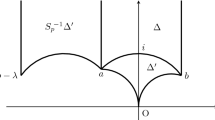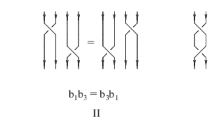Abstract
The recently proposed Kameyama–Nawata–Tao–Zhang (KNTZ ) trick completed the long search for exclusive Racah matrices \( \kern2.3pt\overline{\vphantom{S}\kern3.70831pt}\kern-6.00832pt{S} \) and \(S\) for all rectangular representations. The success of this description is a remarkable achievement of modern knot theory and classical representation theory, which was initially considered a tool for knot calculus but instead turned out to be its direct beneficiary. We show that this approach in fact consists in converting the arborescent evolution matrix \( \kern2.3pt\overline{\vphantom{S}\kern3.70831pt}\kern-6.00832pt{S} \kern1.5pt\overline{\vphantom{{T}}\kern5.23265pt}\kern-6.73265pt{T} ^2 \kern2.3pt\overline{\vphantom{S}\kern3.70831pt}\kern-6.00832pt{S} \) into the triangular form \( \mathcal{B} \), and we demonstrate how this works and show how the previous puzzles and miracles of the differential expansions look from this standpoint. Our conjecture for the form of the triangular matrix \( \mathcal{B} \) in the case of the nonrectangular representation \([3,1]\) is completely new. No calculations are simplified in this case, but we explain how it all works and what remains to be done to completely prove the conjecture. The discussion can also be useful for extending the method to nonrectangular cases and for the related search for gauge-invariant arborescent vertices. As one more application, we present a puzzling, but experimentally supported, conjecture that the form of the differential expansion for all knots is completely described by a particular case of twist knots.

Similar content being viewed by others
REFERENCES
N. M. Dunfield, S. Gukov, and J. Rasmussen, “The superpolynomial for knot homologies,” Exp. Math., 15, 129–159 (2006); arXiv:math/0505662v2 (2005).
H. Itoyama, A. Mironov, A. Morozov, and An. Morozov, “HOMFLY and superpolynomials for figure eight knot in all symmetric and antisymmetric representations,” JHEP, 1207, 131 (2012); arXiv:1203.5978v5 [hep-th] (2012).
A. Mironov, A. Morozov, and An. Morozov, “Evolution method and ‘differential hierarchy’ of colored knot polynomials,” AIP Conf. Proc., 1562, 123–155 (2013); arXiv:1306.3197v1 [hep-th] (2013); “On colored HOMFLY polynomials for twist knots,” Modern Phys. Lett. A, 29, 1450183 (2014); arXiv:1408.3076v2 [hep-th] (2014).
S. B. Arthamonov, A. D. Mironov, and A. Yu. Morozov, “Differential hierarchy and additional grading of knot polynomials,” Theor. Math. Phys., 179 509–542 (2014); arXiv:1306.5682v1 [hep-th] (2013).
J. W. Alexander, “Topological invariants of knots and links,” Trans. Amer. Math. Soc., 30, 275–306 (1928); V. F. R. Jones, “Index for subfactors,” Invent. Math., 72, 1–25 (1983); “A polynomial invariant for knots via von Neumann algebras,” Bull. Amer. Math. Soc., n.s., 12, 103–111 (1985); “Hecke algebra representations of braid groups and link polynomials,” Ann. Math., 126, 335–388 (1987); L. H. Kauffman, “State models and the Jones polynomial,” Topology, 26, 395–407 (1987); P. Freyd, D. Yetter, J. Hoste, W. B. R. Lickorish, K. Millett, and A. Ocneanu, “A new polynomial invariant of knots and links,” Bull. Amer. Math. Soc., n.s., 12, 239–246 (1985); J. H. Przytycki and K. P. Traczyk, “Invariants of links of Conway type,” Kobe J. Math., 4, 115–139 (1987); A. Yu. Morozov, ““Are there \(p\)-adic knot invariants?” Theor. Math. Phys., 187, 447–454 (2016); arXiv:1509.04928v2 [hep-th] (2015).
E. Witten, “Quantum field theory and the Jones polynomial,” Commun. Math. Phys., 121, 351–399 (1989).
R. K. Kaul and T. R. Govindarajan, “Three-dimensional Chern–Simons theory as a theory of knots and links,” Nucl. Phys. B, 380, 293–333 (1992); arXiv:hep-th/9111063v1 (1991); P. Rama Devi, T. R. Govindarajan, and R. K. Kaul, “Three-dimensional Chern–Simons theory as a theory of knots and links (III): Compact semi-simple group,” Nucl. Phys. B, 402, 548–566 (1993); arXiv:hep-th/9212110v1 (1992); P. Ramadevi and T. Sarkar, “On link invariants and topological string amplitudes,” Nucl. Phys. B, 600, 487–511 (2001); arXiv:hep-th/0009188v4 (2000).
E. Guadagnini, M. Martellini, and M. Mintchev, “Chern–Simons field theory and quantum groups,” in: Quantum Groups (Lect. Notes in Phys., Vol. 370, H. D. Doebner and J. D. Hennig, eds.), World Scientific, Singapore (1990), pp. 307–317; “Chern–Simons holonomies and the appearance of quantum groups,” Phys. Lett. B, 235, 275–281 (1990); N. Yu. Reshetikhin and V. G. Turaev, “Ribbon graphs and their invariants derived from quantum groups,” Commun. Math. Phys., 127, 1–26 (1990).
A. Morozov, “Factorization of differential expansion for antiparallel double-braid knots,” JHEP, 1609, 135 (2016); arXiv:1606.06015v8 [hep-th] (2016).
G. Racah, “Theory of complex spectra. II,” Phys. Rev., 62, 438–462 (1942); E. P. Wigner, “On the matrices which reduce the Kronecker products of representations of S. R. groups [1951 unpublished],” in: Quantum Theory of Angular Momentum: A Collection of Reprints and Original Papers (L. C. Biedenharn Jr. and H. van Dam, eds.), Acad. Press, New York, pp. 87–133 (1965); Group Theory and Its Application to the Quantum Mechanics of Atomic Spectra (Pure Appl. Phys., Vol. 5). Acad. Press, New York (1959); L. D. Landau and E. M. Lifshitz, A Course of Theoretical Physics [in Russian], 3, Quantum Mechanics, Nauka, Moscow (1989); English transl. prev. ed., Oxford, Pergamon, (1965); J. S. Carter, D. E. Flath, and M. Saito, The Classical and Quantum \(6j\)-Symbols (Math. Notes, Vol. 43), Princeton Univ. Press, Princeton, N. J. (1995); S. Nawata, P. Ramadevi, and Zodinmawia, “Multiplicity-free quantum \(6j\)-symbols for \(U_q(\mathfrak{sl}_N)\),” Lett. Math. Phys., 103, 1389–1398 (2013); arXiv:1302.5143v3 [hep-th] (2013); A. Mironov, A. Morozov, and A. Sleptsov, “Colored HOMFLY polynomials for the pretzel knots and links,” JHEP, 1507, 069 (2015); arXiv:1412.84322 [hep-th] (2014); V. Alekseev, An. Morozov, and A. Sleptsov, “Interplay between symmetries of quantum 6-j symbols and the eigenvalue hypothesis,” arXiv:1909.07601v3 [hep-th] (2019); “Multiplicity-free \(U_q(sl_N)\) 6-j symbols: Relations, asymptotics, symmetries,” arXiv:1912.13325v3 [hep-th] (2019).
A. Mironov, A. Morozov, An. Morozov, P. Ramadevi, and V. K. Singh, “Colored HOMFLY polynomials of knots presented as double fat diagrams,” JHEP, 1507, 109 (2015); arXiv:1504.00371v3 [hep-th] (2015); S. Nawata, P. Ramadevi, and V. K. Singh, “Colored HOMFLY polynomials that distinguish mutant knots,” arXiv:1504.00364v3 [math.GT] (2015); A. Mironov, R. Mkrtchyan, and A. Morozov, “Universal Racah matrices and adjoint knot polynomials: Arborescent knots,” Phys. Lett. B, 755, 47–57 (2016); arXiv:1511.09077v2 [hep-th] (2015).
M. Kameyama, S. Nawata, R. Tao, and H. D. Zhang, “Cyclotomic expansions of HOMFLY-PT colored by rectangular Young diagrams,” arXiv:1902.02275v2 [math.GT] (2019).
A. Morozov, “On exclusive Racah matrices \(\overline S\) for rectangular representations,” Phys. Lett. B, 793, 116–125 (2019); arXiv:1902.04140v6 [hep-th] (2019).
A. Morozov, “Extension of KNTZ trick to non-rectangular representations,” Phys. Lett. B, 793, 464–468 (2019); arXiv:1903.00259v2 [hep-th] (2019).
A. Morozov, “Pentad and triangular structures behind the Racah matrices,” Eur. Phys. J. Plus, 135, 196 (2020); arXiv:1906.09971v1 [hep-th] (2019).
S. Gukov, A. Schwarz, and C. Vafa, “Khovanov–Rozansky homology and topological strings,” Lett. Math. Phys., 74, 53–74 (2005); arXiv:hep-th/0412243v3 (2004).
M. Aganagic and Sh. Shakirov, “Knot homology from refined Chern–Simons theory,” arXiv:1105.5117v2 [hep-th] (2011); “Refined Chern–Simons theory and knot homology,” in: String-Math 2011 (Proc. Symp. Pure Math., Vol. 85, J. Block, J. Distler, R. Donagi, and E. Sharpe, eds.), Amer. Math. Soc., Providence, R. I. pp. 3–31 (2012); arXiv:1202.2489v1 [hep-th] (2012); “Refined Chern–Simons theory and topological string,” arXiv:1210.2733v1 [hep-th] (2012); P. Dunin-Barkowski, A. Mironov, A. Morozov, A. Sleptsov, and A. Smirnov, “Superpolynomials for torus knots from evolution induced by cut-and-join operators,” JHEP, 1303, 021 (2013); arXiv:1106.4305v4 [hep-th] (2011); I. Cherednik, “Jones polynomials of torus knots via DAHA,” arXiv:1111.6195v10 [math.QA] (2011).
A. Okounkov and G. Olshanskii, “Shifted Schur functions,” St. Petersburg Math. J., 9, 239–300 (1998); “Shifted Jack polynomials, binomial formula, and applications,” Math. Res. Lett., 4, 69–78 (1997); arXiv:q-alg/9608020v2 (1996).
A. Okounkov, “Binomial formula for Macdonald polynomials,” arXiv:q-alg/9608021v2 (1996).
E. Gorsky, S. Gukov, and M. Stosic, “Quadruply-graded colored homology of knots,” Fund. Math., 243, 209–299 (2018); arXiv:1304.3481v1 [math.QA] (2013).
S. Nawata and A. Oblomkov, “Lectures on knot homology,” in: Physics and Mathematics of Link Homology (Centre de Recherches Mathématiques, Université de Montreal, Montreal, QC, 24 June–5 July, 2013, S. Gukov, M. Khovanov, and J. Walcher, eds.), Amer. Math. Soc., Providence, R. I. (2016), pp. 137-177; arXiv:1510.01795v5 [math-ph] (2015).
A. Anokhina and A. Morozov, “Are Khovanov–Rozansky polynomials consistent with evolution in the space of knots?” JHEP, 1804, 66 (2018); arXiv:1802.09383v1 [hep-th] (2018); P. Dunin-Barkowski, A. Popolitov, and S. Popolitova, “Evolution for Khovanov polynomials for figure-eight-like family of knots,” arXiv:1812.00858v3 [math-ph] (2018); A. Anokhina, A. Morozov, and A. Popolitov, “Nimble evolution for pretzel Khovanov polynomials,” Eur. Phys. J. C, 79, 867 (2019); arXiv:1904.10277v2 [hep-th] (2019).
D. Galakhov, D. Melnikov, A. Mironov, A. Morozov, and A. Sleptsov, “Colored knot polynomials for arbitrary pretzel knots and links,” Phys. Lett. B, 743, 71–74 (2015); arXiv:1412.2616v1 [hep-th] (2014); A. Mironov, A. Morozov, and A. Sleptsov, “Colored HOMFLY polynomials for the pretzel knots and links,” JHEP, 1507, 069 (2015); arXiv:1412.8432v2 [hep-th] (2014); D. Galakhov, D. Melnikov, A. Mironov, A. Morozov, and A. Sleptsov, “Knot invariants from Virasoro related representation and pretzel knots,” Nucl. Phys. B, 899, 194–228 (2015); arXiv:1502.02621v1 [hep-th] (2015); A. Mironov, A. Morozov, An. Morozov, and A. Sleptsov, “Quantum Racah matrices and \(3\)-strand braids in irreps \(R\) with \(|R|=4\),” JETP Lett., 104, 56–61 (2016); arXiv:1605.03098v1 [hep-th] (2016); Sh. Shakirov and A. Sleptsov, “Quantum Racah matrices and 3-strand braids in representation [3,3],” arXiv:1611.03797v2 [hep-th] (2016); S. Arthamonov and Sh. Shakirov, “Genus two generalization of \(A_1\) spherical DAHA,” Selecta Math., 25, 17 (2019); arXiv:1704.02947v1 [math.QA] (2017).
A. Morozov, “Differential expansion and rectangular HOMFLY for the figure eight knot,” Nucl. Phys., 911, 582–605 (2015); arXiv:1605.09728v3 [hep-th] (2016).
Ya. A. Kononov and A. Yu. Morozov, “Rectangular superpolynomials for the figure-eight knot \(4_1\),” Theor. Math. Phys., 193, 1630–1646 (2017).
Ya. Kononov and A. Morozov, “On rectangular HOMFLY for twist knots,” Modern. Phys. Lett. A, 31, 1650223 (2016); arXiv:1610.04778v1 [hep-th] (2016).
A. Morozov, “Factorization of differential expansion for non-rectangular representations,” Modern. Phys. Lett. A, 33, 1850062 (2018); arXiv:1612.00422v3 [hep-th] (2016).
A. Morozov, “On moduli space of symmetric orthogonal matrices and exclusive Racah matrix \(\overline{S}\) for representation \(R=[3,1]\) with multiplicities,” Phys. Lett. B, 766, 291–300 (2017); arXiv:1701.00359v2 [hep-th] (2017).
A. Morozov, “HOMFLY for twist knots and exclusive Racah matrices in representation [333],” Phys. Lett. B, 778, 426–434 (2018); arXiv:1711.09277v3 [hep-th] (2017).
A. Mironov, A. Morozov, An. Morozov, P. Ramadevi, V. Kumar Singh, and A. Sleptsov, “Tabulating knot polynomials for arborescent knots,” J. Phys. A: Math. Theor., 50 085201 (2017); arXiv:1601.04199v2 [hep-th] (2016).
K. Koike, “On the decomposition of tensor products of the representations of the classical groups: By means of the universal characters,” Adv. Math., 74, 57–86 (1989).
H. Kanno, “Universal character and large \(N\) factorization in topological gauge/string theory,” Nucl. Phys. B, 745, 165–175 (2006); arXiv:hep-th/0602179v2 (2006). ; A. Mironov and A. Morozov, “On the Hopf-induced deformation of topological locus,” JETP Lett., 107, 728–735 (2018); arXiv:1804.10231v1 [hep-th] (2018); “Kerov functions for composite representations and Macdonald ideal,” Nucl. Phys. B, 944, 114641 (2019); arXiv:1903.00773v1 [hep-th] (2019); H. Awata, H. Kanno, A. Mironov, and A. Morozov, “Can tangle calculus be applicable to hyperpolynomials?” Nucl. Phys. B, 949, 114816 (2019); arXiv:1905.00208v1 [hep-th] (2019).
Ya. Kononov and A. Morozov, “On the defect and stability of differential expansion,” JETP Lett., 101, 831–834 (2015); arXiv:1504.07146v3 [hep-th] (2015).
L. Bishler and A. Morozov, “Perspectives of differential expansion,” arXiv:2006.01190v1 [hep-th] (2020).
J. Gu and H. Jockers, “A note on colored HOMFLY polynomials for hyperbolic knots from WZW models,” Commun. Math. Phys., 338, 393–456 (2015); arXiv:1407.5643v3 [hep-th] (2014).
A. Anokhina, A. Mironov, A. Morozov, and An. Morozov, “Knot polynomials in the first non-symmetric representation,” Nucl. Phys. B, 882, 171–194 (2014); arXiv:1211.6375v1 [hep-th] (2012).
Funding
This research was supported in part by a grant from the Russian Science Foundation (Project No. 16-12-10344).
Author information
Authors and Affiliations
Corresponding author
Ethics declarations
The author declares no conflicts of interest.
Appendix
In this appendix, we present the fragment of \( \mathcal{B} ^{ \mathrm{rel} }\) that includes all the representations in \([3,1]\times \overline {[3,1]}\). We described its role and applications in Sec. 10.2. The full \(10{\times}10\) matrix \( \mathcal{B} \) in these coordinates also has a block form: the blocks of \( \mathcal{B} ^{ \mathrm{rel} }_{[3,1]}\) are
Rights and permissions
About this article
Cite this article
Morozov, A.Y. The KNTZ trick from arborescent calculus and the structure of the differential expansion. Theor Math Phys 204, 993–1019 (2020). https://doi.org/10.1134/S0040577920080036
Received:
Revised:
Accepted:
Published:
Issue Date:
DOI: https://doi.org/10.1134/S0040577920080036




